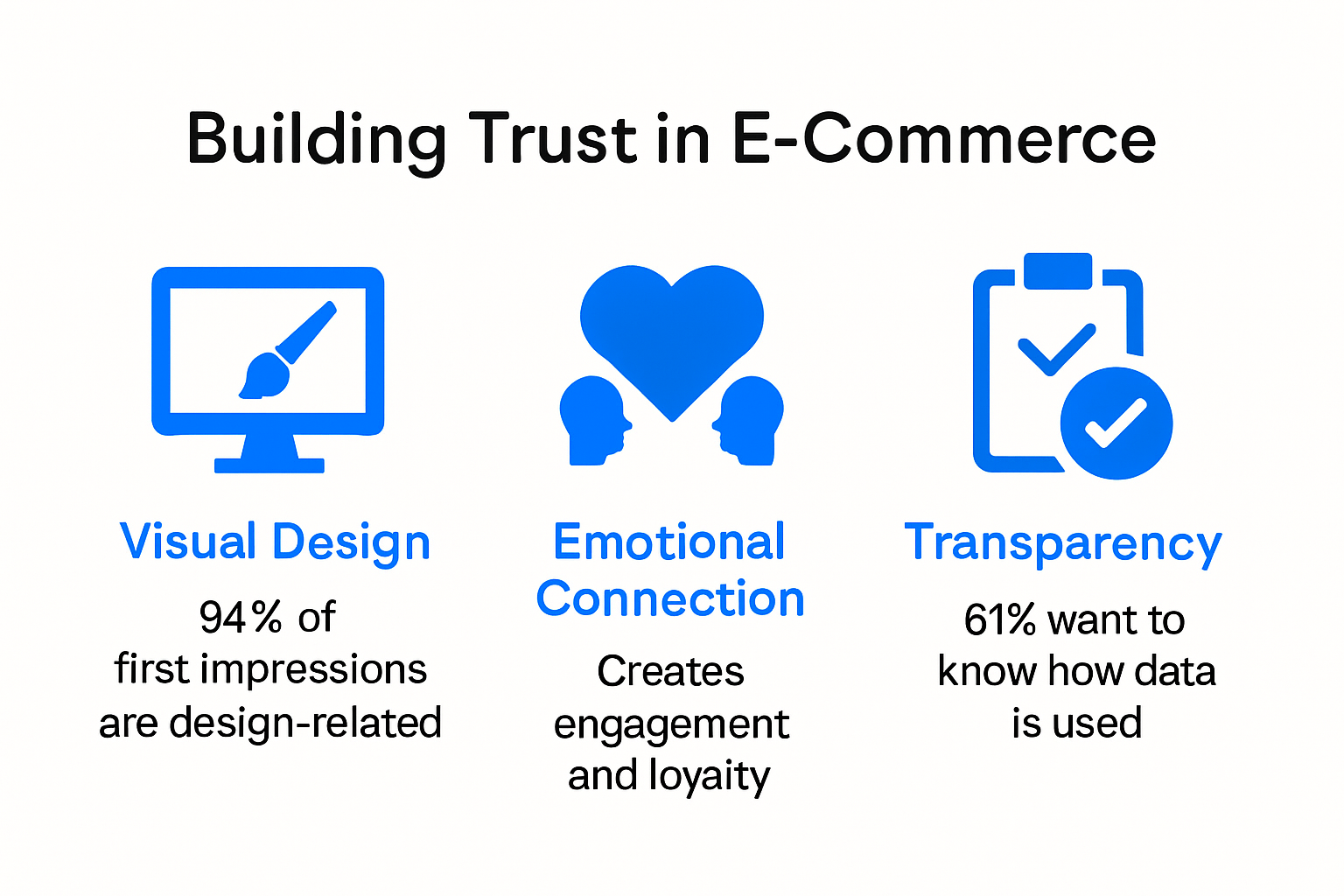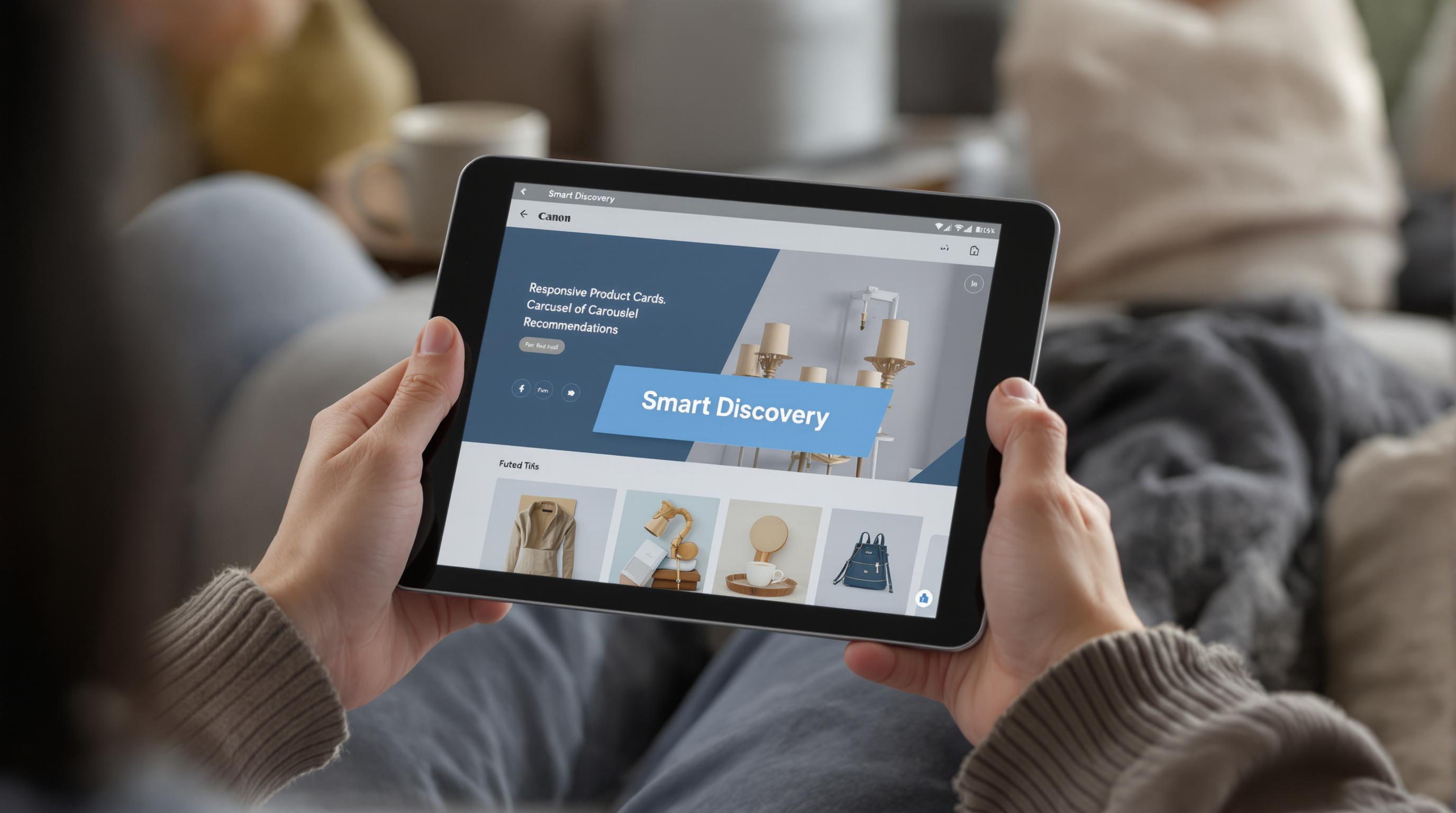UX Design for Ecommerce: Essential Strategies for 2025
UX design for ecommerce is often viewed as a matter of colors, buttons, and page layouts. Yet, the numbers reveal a different story. Research shows that up to 18% of shoppers abandon their carts simply due to a confusing or lengthy checkout process. The real secret behind the most successful online stores is not just a beautiful site. The twist is that subtle user experience tweaks—like mobile-first layouts and trust signals—can unlock massive sales gains that most brands miss entirely.
Table of Contents
- Building Trust Through User-Centered Design
- Optimizing Navigation And Product Discovery
- Enhancing Checkout Experience For Higher Sales
- Leveraging Mobile-First UX For Ecommerce Success
Quick Summary
| Takeaway | Explanation |
|---|---|
| User-Centered Design Builds Trust | Prioritizing user needs enhances emotional connections and reliability, with visual design elements signaling professionalism and fostering customer loyalty. |
| Optimize Navigation for Product Discovery | Implement interactive visual navigation and personalized recommendation systems to guide users while reducing cognitive load, making product discovery more engaging. |
| Streamline Checkout Experience | Minimize friction during checkout by offering guest options and incorporating multiple payment methods, alongside trust signals that reinforce user confidence. |
| Focus on Mobile-First UX Design | Create intuitive mobile navigation and ensure streamlined checkout processes with mobile-friendly payment options to align with user preferences for a seamless shopping experience. |
Building Trust Through User-Centered Design

User-centered design represents a critical strategy for building trust in ecommerce platforms. By prioritizing user needs and experiences, businesses can create digital environments that not only attract customers but also establish long-lasting relationships rooted in reliability and transparency.
Visual Design and Psychological Trust
Visual design plays a pivotal role in establishing immediate user trust. Research from the 11th Nordic Conference on Human-Computer Interaction demonstrates that professional website aesthetics significantly influence users’ trust perceptions. This means every visual element from color schemes to typography communicates a subtle message about your brand’s credibility.
Key visual trust signals include consistent branding, high-quality imagery, clean layouts, and intuitive navigation. Customers subconsciously evaluate a website’s professionalism within milliseconds. Poorly designed interfaces signal potential unreliability, while polished designs suggest competence and attention to detail.
User Experience and Emotional Connection
Research published in the International Journal of Intelligent Systems and Applications reveals that positive user experiences directly enhance customer trust and loyalty. This goes beyond aesthetic appeal and enters the realm of emotional engagement. Users want to feel understood, supported, and valued throughout their digital journey.
Effective user-centered design anticipates user needs before they arise. This means creating clear pathways, reducing friction in navigation, providing transparent information about products and services, and offering multiple support channels. Predictive design elements like intelligent search functions, personalized recommendations, and easy-to-understand pricing structures demonstrate your commitment to user satisfaction.
Psychological Safety and Transparency
According to the Proceedings of the American Society for Information Science and Technology , building online trust requires a holistic approach considering graphic design, structural integrity, content quality, and social cues. Users seek psychological safety when engaging with digital platforms.
Transparency becomes a crucial trust-building mechanism. This means clearly displaying contact information, providing detailed product descriptions, showcasing genuine customer reviews, and implementing secure payment gateways. Security badges, SSL certificates, and clear privacy policies communicate your dedication to protecting user data.
By integrating these user-centered design principles, businesses can transform their ecommerce platforms from transactional spaces into trusted digital environments where customers feel valued, understood, and confident in their interactions.
To help clarify the different trust-building strategies discussed, the following table summarizes their key elements and impact:
| Strategy | Key Elements | Impact on User Trust |
|---|---|---|
| Visual Design | Consistent branding, quality imagery, clean layouts, navigation | Signals professionalism and reliability |
| Emotional Connection (UX) | Clear pathways, support channels, predictive design elements | Makes users feel valued and understood |
| Psychological Safety & Transparency | Contact info, reviews, secure payments, privacy policies | Reinforces reliability and data protection |
Optimizing Navigation and Product Discovery
Effective navigation and product discovery are critical components of user experience in ecommerce platforms. A well-designed navigation system transforms browsing from a potential frustration into an intuitive, engaging journey that guides users seamlessly toward their desired products.
Interactive Visual Navigation
Researchers exploring Interactive Visual Facets have developed innovative approaches to enhance exploratory search in ecommerce platforms. These advanced navigation systems go beyond traditional menu structures by providing dynamic, visual methods for users to understand and control their product exploration. Interactive interfaces allow users to filter, sort, and visualize product ranges with unprecedented clarity and ease.
Key strategies include implementing multi-dimensional filtering, color-coded category visualization, and responsive design elements that adapt to user interactions. By creating more intuitive navigation paths, businesses can significantly reduce user cognitive load and increase the likelihood of product discovery and purchase.
Personalized Recommendation Systems

Advanced neural network research demonstrates the transformative potential of personalized recommendation systems in optimizing product discovery. These intelligent systems analyze user behavior, preferences, and historical interactions to dynamically curate product suggestions that align precisely with individual user interests.
Personalization goes beyond simple categorical recommendations. Modern recommendation engines utilize complex algorithms that consider nuanced factors such as browsing history, previous purchases, time spent on product pages, and even contextual information like seasonal trends or current user preferences. By presenting users with highly targeted product recommendations, businesses can dramatically improve click-through rates and conversion potential.
Reducing Information Overload
Research in ecommerce recommendation strategies highlights a critical challenge in product discovery: information overload. The study revealed that personalized navigation approaches can reduce information overwhelm by up to 29.4%, simultaneously increasing revenue by 7%.
To achieve this, successful platforms implement strategies like progressive disclosure, where product information is revealed incrementally. This might include compact product cards with essential details, expandable sections for more information, and intuitive comparison tools that allow users to quickly assess multiple products without feeling inundated.
Effective navigation is not just about showing products but about creating an intelligent, responsive environment that understands and anticipates user needs. By combining interactive visual design, personalized recommendations, and strategic information presentation, ecommerce platforms can transform product discovery from a potential source of frustration into an engaging, satisfying user experience.
To clarify and compare key navigation and product discovery strategies mentioned above, here is a summary table:
| Navigation Strategy | Description | Benefits |
|---|---|---|
| Interactive Visual Facets | Multi-dimensional filtering, color-coded categories, dynamic visualization | Reduces cognitive load, guides product exploration |
| Personalized Recommendations | Tailored product suggestions based on user data and behavior | Increases relevance, improves conversion |
| Progressive Disclosure | Incremental information reveal, compact cards, expandable sections | Reduces overload, speeds comparison |
Enhancing Checkout Experience for Higher Sales
The checkout process represents the critical final stage of the customer journey in ecommerce, where user experience can dramatically impact conversion rates and overall sales performance. A streamlined, intuitive checkout experience can mean the difference between a completed purchase and an abandoned cart.
Minimizing Friction and Complexity
Research from the Baymard Institute reveals that 18% of users abandon their purchase due to complex or lengthy checkout processes. This highlights the paramount importance of creating a frictionless transaction pathway. Successful ecommerce platforms focus on reducing unnecessary steps, simplifying form fields, and providing clear guidance throughout the checkout journey.
Key strategies include implementing single-page checkout designs, offering guest checkout options, and using smart form autofill technologies. Reducing the cognitive load during purchase means fewer distractions and a higher likelihood of completing the transaction. Businesses should aim to collect only essential information, using progressive disclosure techniques to minimize perceived complexity.
Payment Flexibility and Trust Signals
A study by Forrester Research demonstrates that offering multiple payment options can increase conversion rates by up to 30%. Modern consumers expect flexibility in payment methods, including digital wallets, credit cards, buy-now-pay-later services, and emerging payment technologies.
Trust signals become crucial during the checkout process. This includes displaying security badges, using SSL encryption, showing accepted payment methods prominently, and providing clear information about data protection. Transparent pricing, with no hidden fees, also plays a significant role in building user confidence. Visual cues that communicate security and reliability can significantly reduce last-minute purchase hesitation.
Mobile Optimization and Responsive Design
With mobile commerce continuing to grow exponentially, checkout experiences must be seamlessly responsive across all device types. Google’s Mobile Conversion Research indicates that mobile-optimized checkout processes can improve conversion rates by up to 25%.
Responsive design goes beyond mere visual adaptation. It involves creating touch-friendly interfaces, implementing large, easy-to-tap buttons, and ensuring that form fields are easily navigable on smaller screens. Intelligent features like automatic address detection, simplified mobile payment options, and one-click purchasing can transform the mobile checkout experience from frustrating to frictionless.
The checkout process is more than a transactional endpoint. It represents the final opportunity to reinforce brand trust, demonstrate user-centric design, and create a positive lasting impression. By focusing on simplicity, flexibility, and technological innovation, businesses can turn the checkout experience from a potential point of friction into a smooth, confidence-building interaction that encourages repeat purchases and customer loyalty.
The following table organizes key checkout optimization statistics and strategies referenced in this section for quick reference:
| Aspect of Checkout | Statistic/Fact | Optimization Strategies |
|---|---|---|
| Checkout Complexity | 18% abandon carts due to confusing process | Single-page, guest checkout, autofill forms |
| Payment Flexibility | +30% conversion with multiple payment methods | Offer wallets, credit, BNPL, digital options |
| Mobile Optimization | Up to 25% higher conversion on mobile-optimized | Large buttons, responsive forms, 1-tap pay |
| Trust/Security | Trust signals reduce purchase hesitation | Security badges, SSL, transparent pricing |
Leveraging Mobile-First UX for Ecommerce Success
Mobile devices have transformed the digital shopping landscape, making mobile-first UX design a critical strategy for ecommerce success. With smartphone users increasingly preferring mobile platforms for online shopping, businesses must prioritize creating seamless, intuitive mobile experiences that meet evolving user expectations.
Intuitive Mobile Navigation and Design
Research on mobile application user experience reveals that intuitive navigation, appealing visuals, and performance optimization are fundamental principles for engaging mobile users. Successful mobile UX design requires reimagining traditional desktop interfaces to suit smaller screens and touch-based interactions.
Key design considerations include implementing large, easily tappable buttons, using clear hierarchical information structures, and creating responsive layouts that adapt dynamically to different device sizes. Simplified menu structures, hamburger menus, and gesture-based navigation can significantly enhance user interaction. The goal is to create an interface that feels natural and effortless, reducing cognitive load and making product exploration enjoyable.
Product Visualization and Interactive Elements
Experts from Toptal highlight the importance of advanced product visualization in mobile ecommerce experiences. Users expect sophisticated image interaction capabilities, such as pinch-to-zoom and double-tap gestures that allow detailed product inspection. High-resolution images, 360-degree product views, and interactive color/variant selectors can compensate for the limited screen real estate.
Additionally, implementing touch-friendly features like swipeable image galleries, interactive size guides, and context-aware recommendations can transform mobile product browsing from a potentially frustrating experience into an engaging journey. These interactive elements not only provide practical information but also create a sense of digital tactility that mimics in-store shopping experiences.
Streamlined Mobile Checkout and Payment
Shopify’s mobile UX guidelines emphasize the critical role of optimized checkout processes in mobile commerce. Integrating mobile-friendly payment options like Apple Pay and Google Pay can dramatically reduce friction during transactions. Address autocomplete, minimal form fields, and one-tap payment technologies are no longer luxuries but essential components of a competitive mobile shopping experience.
Security remains paramount. Mobile users are particularly sensitive to trust signals, so prominently displaying security badges, using clear encryption indicators, and providing transparent payment information can alleviate potential hesitations. Implementing biometric authentication methods like fingerprint or facial recognition can further enhance both security and convenience.
Mobile-first UX design represents more than a technical adaptation. It is a comprehensive approach to understanding and anticipating user needs in a mobile-dominated digital ecosystem. By creating experiences that are not just mobile-compatible but genuinely mobile-optimized, businesses can transform smartphone screens from potential barriers into powerful sales channels that delight and engage customers.
Frequently Asked Questions
What is UX design in ecommerce?
UX design in ecommerce refers to the process of enhancing user satisfaction by improving the usability, accessibility, and overall experience of online shopping platforms. It focuses on creating user-centered designs that facilitate positive interactions and lead to higher conversion rates.
How can I build trust through UX design in my ecommerce site?
You can build trust by implementing visual design elements that signal professionalism, offering transparent information such as contact details, and showcasing genuine customer reviews. Additionally, providing strong security measures during transactions can reinforce user confidence.
What are some key strategies for optimizing navigation in ecommerce?
Key strategies for optimizing navigation include using interactive visual navigation that reduces cognitive load, implementing personalized recommendation systems that cater to individual preferences, and utilizing progressive disclosure techniques to minimize information overload.
How can I enhance the checkout experience on my ecommerce website?
To enhance the checkout experience, focus on minimizing friction and complexity by simplifying forms and enabling guest checkout. Offering multiple payment options and incorporating trust signals, such as security badges, can also help boost user confidence and encourage completed transactions.
Ready to Turn Ecommerce Challenges Into Conversion Wins?
You have just read how poor navigation, cluttered layouts, and clunky checkouts can drive your customers away. The article highlighted that confusing checkout flows, lack of trust signals, and non-responsive mobile design cause users to abandon their shopping carts. These pain points are not just theory. They cost real revenue every day. If you want your store to deliver frictionless product discovery, boost trust, and increase sales on every device, it is time to act.

Take the next step to build a user experience that earns trust and lifts your bottom line . The TRAVLRD team specializes in creating custom ecommerce websites and mobile apps that solve these exact issues. We combine conversion-oriented design, seamless checkout flows, and personalized product journeys so your business stands out. Discover how our digital development experts can help you solve your biggest UX problems. Book a free consultation at TRAVLRD today to get tailored solutions that work for you right now.







